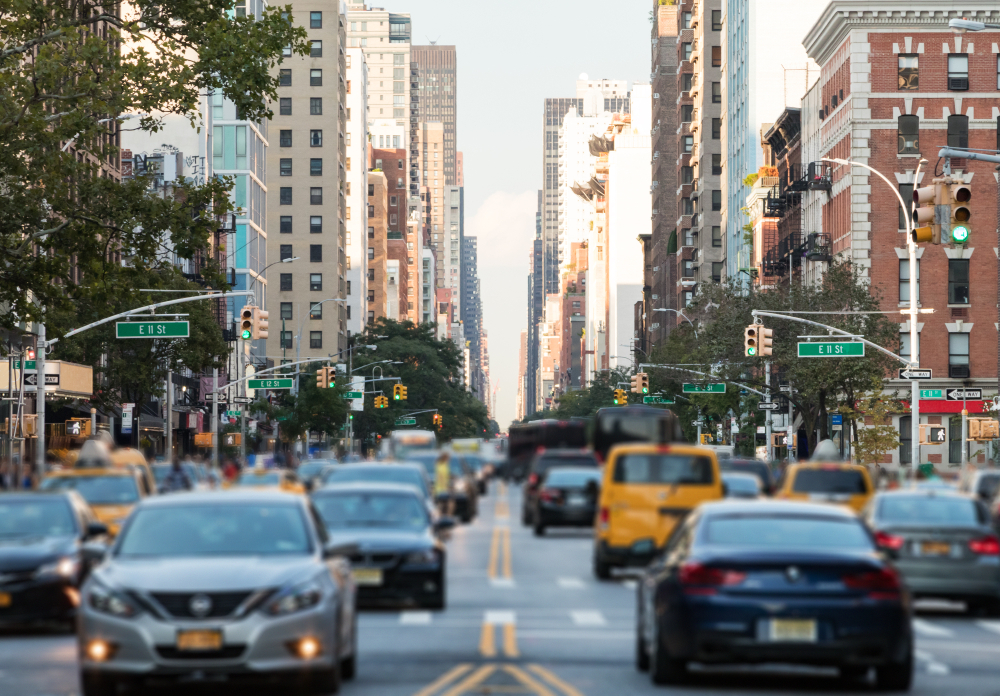New York City’s congestion pricing program is moving forward with a $15 fee on passenger vehicles, reports Stephen Nessen in Gothamist, after the MTA board voted to approve it. The program now enters a 60-day public comment period before a final vote.
Nessen points out that “The stakes are high for the program. Congestion pricing has been successfully implemented in other countries. But the MTA’s program represents the first effort in the United States to impose a fee to reduce gridlock.” Additionally, “The tolls are required by law to back $15 billion worth of loans, which accounts for nearly a third of the MTA’s 2020-2024 construction program.”
The program includes exemptions and fare discounts for low-income drivers, emergency vehicles, and drivers who already pay certain tolls. “Small trucks, buses and vans face a $24 charge during those hours, while large trucks, including big rigs, will have to pay $36. Motorcycles will be tolled a $7.50 daytime fee.” The fee is reduced by 75 percent during nighttime hours.



I and most other people are riding around on stock engines with stock exhausts. Those confirm to stricter quiet standards in Japan than anywhere in the US.
To your second point, modern car engines have efficiency gains due to important innovations like direct fuel injection, whereas most motorcycles are stuck with port injection, a limitation currently forced by the fear of having a very high pressure fuel pump between rider’s legs…
In spite of that, total bike emissions are lower for the same distance vs a car, we’re not lugging an entire chassis, air conditioning etc. The result is that even carbureted bikes from the 80s could go 55-60mpg. Bikes also have much lower engine displacement, your v6 2L has about 2000 cm^3 of air and fuel burned per revolution, whereas most motorcycles are in the 6-800 cm^3 range, per rev.
Manufacturers could make them quieter, but that adds both weight and cost, more of one if you adjust the other. I look forward to electric bikes with great range, as I don’t really do more than 350 miles on my long trips unless I’m late for something.
E: looks like Japan relaxed their standards since 2013, per some internal documentation, see slide 9 for harmonized requirements. Still quiet, all things considered.
Neat, thanks for the additional insight!
Motorcycles are still FAR noisier than cars, even brand new with the OEM exhaust. I don’t think my stock bike is overly obnoxious, but it’s certainly the noisiest vehicle around most of the time. Modern cars you don’t even necessarily notice the engine from further than a few feet away.
Also, motorcycles have lower carbon emissions than most cars, but higher everything else. Can’t exactly fit a catalytic converter on there. NOx, fine particulates, etc, are all much worse than a car’s IIRC.
In the end these factors don’t matter much because motorcycles in the West are mostly a hobby, so there’s typically not enough of us to be a huge societal problem. However, if I’m going in the city I usually opt for my ebike because I live close enough and it doesn’t make sense to annoy everyone with my noisy dinosaur fart machine.
You’re partially correct, older bikes didn’t have catalytic converters. Compliance with Euro 5 means all new models past… 2018 I think, must have one equipped.
As for noise, 75db is louder than a modern car, but we don’t have room onboard to dissipate a lot of the sound energy like a car’s long, standing-wave tuned exhaust does.
I don’t have a car, just a bicycle and motorcycle. I like them both, though I trust my bicycle more when there’s a blizzard.
P.s. I also like fortnine videos, he’s mostly correct (though dead wrong about physicists being the grownup version of engineers) but look at the data for yourself. Keep in mind all these values are far, far lower than they used to be. We shouldn’t stop striving for better, but we should keep things in perspective too: https://www.bts.gov/content/estimated-national-average-vehicle-emissions-rates-vehicle-vehicle-type-using-gasoline-and